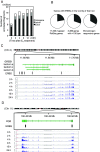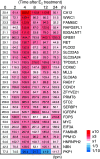RNA sequencing of MCF-7 breast cancer cells identifies novel estrogen-responsive genes with functional estrogen receptor-binding sites in the vicinity of their transcription start sites
- PMID: 23526455
- PMCID: PMC10358060
- DOI: 10.1007/s12672-013-0140-3
RNA sequencing of MCF-7 breast cancer cells identifies novel estrogen-responsive genes with functional estrogen receptor-binding sites in the vicinity of their transcription start sites
Abstract
Estrogen receptor α (ERα) is a key transcription factor in breast cancer, which plays an essential role in the pathophysiology of the disease by regulating the expression of various target genes. In the present study, we performed deep RNA sequencing (RNA-seq) as an unbiased high-throughput technique for comprehensive transcriptome analysis in ERα-positive human breast cancer MCF-7 cells, to facilitate the elucidation of ERα regulatory gene networks. From the 17,336 mapped RefSeq genes from the sequenced fragments of the cell samples treated with estrogen time dependently, substantial numbers of sequence reads were observed in 3,386 genes (>100 tags per million reads per sample at any of the six time points studied). ERα occupancy within and in the proximal regions of the genes (<10-kb upstream and downstream regions) was significantly enriched in the subgroup of the 3,386 genes compared to the whole 17,336 RefSeq genes. Of the 3,386 genes, we focused on 29 genes, which included ERα occupancy adjacent to their transcription start sites and whose expression was estrogen dependently altered by >3-fold. Knockdown studies using siRNAs specific to the 29 genes validated that prototypic ERα targets V-myc myelocytomatosis viral oncogene homolog and cyclin D1 promote both proliferation and migration of MCF-7 cells and further identified novel candidate ERα targets EIF3A and tumor protein D52-like 1, which will also facilitate the proliferation or migration of MCF-7 cells. Taken together, the present findings provide a valuable dataset that will elucidate ERα regulatory mechanisms in breast cancer biology, based on the integrative analysis of RNA-seq combined with the genome-wide information for ERα occupancy.
Figures






References
Publication types
MeSH terms
Substances
LinkOut - more resources
Full Text Sources
Other Literature Sources
Medical
Research Materials
Miscellaneous

